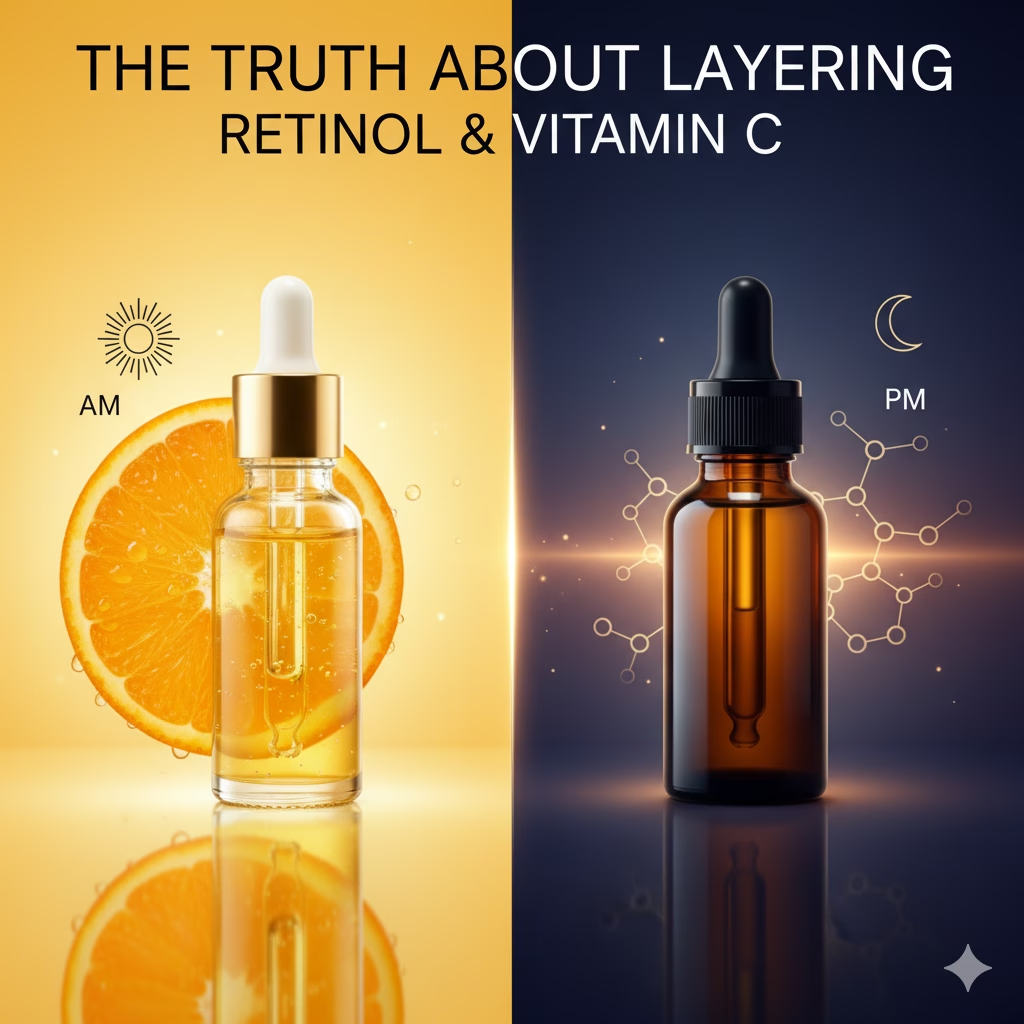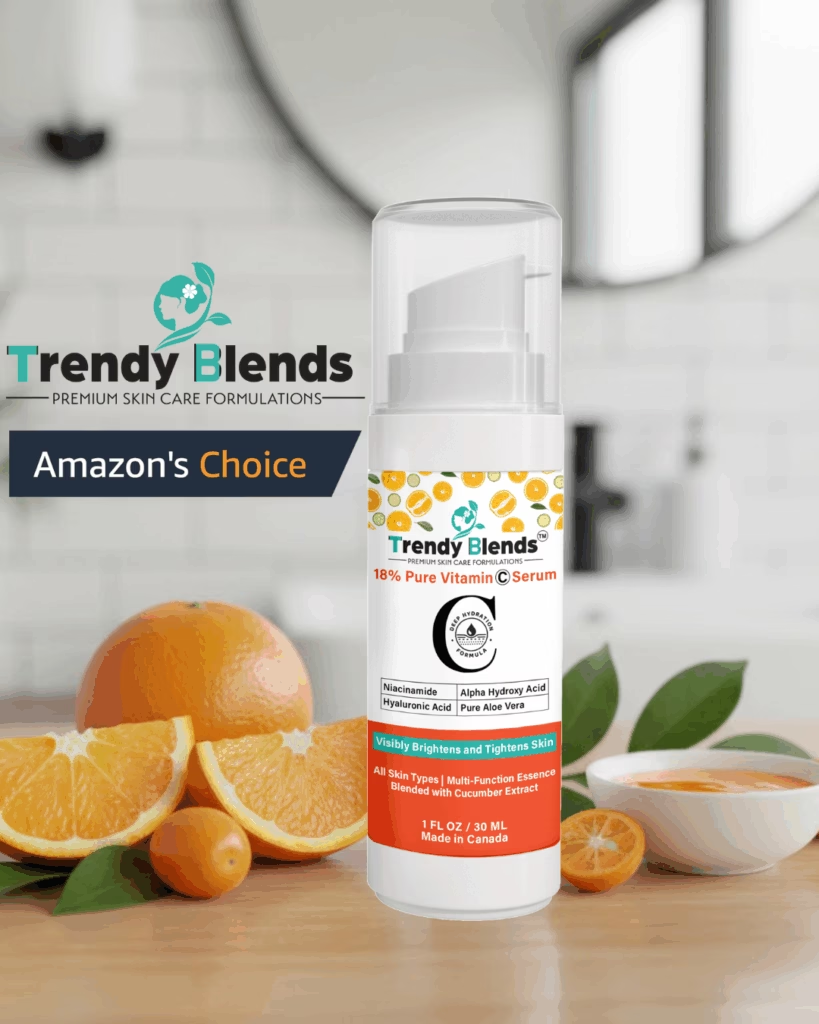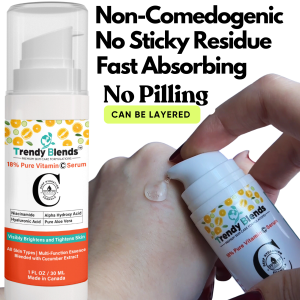The Truth About Layering: Can You Really Use Retinol and Vitamin C Together?

Discover the Truth About Layering: Can You Really Use Retinol and Vitamin C Together?
It’s the ultimate skincare dilemma: You’ve invested in the two most powerful ingredients for glowing, youthful skin—Vitamin C Serum for its morning antioxidant shield and Retinol for its nighttime repair magic. But a quick online search is likely to tell you the same thing: Never put them on at the same time.
The old wisdom warned that these two powerhouses would deactivate each other, making both products useless. The modern reality is different. Today’s sophisticated formulas are much more stable, which means the confusion isn’t about if you can use them, but how to use them without causing a scorched, irritated skin barrier. If you’re wondering how to harness the brightening power of Vitamin C and the wrinkle-smoothing benefits of Retinol in a single routine without the drama, you’ve come to the right place. We’re breaking down the science, busting the biggest myth, and giving you the perfect, dermatologist-approved schedule to make these two work together flawlessly.
The Solution: Timing is Everything (AM vs. PM)
The best way to use the skincare gold standards is not by trying to cocktail them into one session, but by strategically separating them into your morning and evening routines. This simple act respects their unique benefits, pH needs, and optimal working hours, maximizing their power while minimizing the risk of irritation.
Why You Must Separate Retinol and Vitamin C (It’s Not pH Anymore)
The decades-old advice to avoid mixing these two was rooted in concern over stability—specifically, that the high acidity required by pure Vitamin C (L-Ascorbic Acid) would destabilize the Retinol. Modern encapsulation and stable derivatives have lessened this risk, but the truth remains: using both powerful actives together can severely compromise your skin barrier, leading to redness, dryness, and inflammation. By separating them, you allow each ingredient to work effectively without overwhelming the skin.
Vitamin C in the Morning: Your Skin’s Must-Have Antioxidant Shield
Vitamin C Serum is your daylight defender. While most people think of it for brightening dark spots, its primary function during the day is as a potent antioxidant. It acts as a shield to neutralize the damaging free radicals created by UV rays, pollution, and blue light.
| When to Use | The Primary Goal | Key Pairing |
| Immediately after cleansing and toning. | Protect the skin from environmental stressors. | Must be followed by a broad-spectrum SPF 30+. |
Retinol at Night: Optimizing Cell Turnover and Collagen Production
Retinol (a form of Vitamin A) is the ultimate night shift worker. Since it can be broken down by sunlight and makes your skin more sun-sensitive, it’s an ingredient best used when your skin is naturally focused on cellular repair and recovery. It accelerates cell turnover, promoting the growth of fresh new cells to smooth texture, fade lines, and clear pores.
The Golden Rule: When to Apply Vitamin C Before SPF
Your morning routine is incomplete without sunscreen. Think of your Vitamin C serum as the inner armor and SPF as the outer helmet. Apply your Vitamin C first, allow it to absorb for a minute, and then apply a generous amount of broad-spectrum sunscreen. This pairing creates the most powerful defensive team against premature aging.
A Simple Routine Schedule: AM vs. PM Skincare Sequence
| Time | Routine Type | Key Active | Secondary Focus |
| Morning (AM) | Protection | Vitamin C Serum | Antioxidants, Hydration, SPF |
| Evening (PM) | Renewal | Retinol | Repair, Moisturizing, Barrier Support |

Advanced Layering: If You Must Use Both at Night
If you have resilient skin or wish to maximize benefits, there are two primary methods to prevent these ingredients from causing inflammation: Skin Cycling or the Wait Time technique.
1. The Skin Cycling Method
This is the gentlest way to use both. It involves alternating your nightly actives to give your skin necessary recovery time. A typical four-night cycle looks like this:
- Night 1: Exfoliation/Vitamin C. Use your Vitamin C serum or a chemical exfoliant.
- Night 2: Retinol. Apply your retinoid product.
- Nights 3 & 4: Recovery. Use only gentle cleansers, hydrating serums (like Hyaluronic Acid), and a rich barrier-supportive moisturizer.
2. The Buffering & Wait Time Technique
This method is for the experienced user who wants both on the same night.
- Start with Vitamin C. Apply your serum after cleansing.
- Wait 15-20 Minutes. This crucial step allows the Vitamin C to fully absorb and lets your skin’s pH level re-balance before applying the Retinol.
- Apply Retinol. Follow up with your retinoid.
- Seal with a Buffer. Finish with a generous layer of moisturizer.
Expert Note: This method significantly increases the risk of dryness and irritation. The simple AM/PM separation is nearly always the safest and most effective choice.
Product Guide: Our Top-Rated Retinol & Vitamin C Picks
To help you get started, here are specific, highly-rated product recommendations for building your optimized routine, categorized by budget:
| Category | Gold Standard (Splurge) | High-Performance (Mid-Range) | Budget-Friendly (Drugstore) |
| Vitamin C (AM) | Trendy Blends Vitamin C Serum | Trendy Blends Vitamin C Serum | CeraVe Skin Renewing Vitamin C Serum |
| Retinol (PM) | SkinCeuticals Retinol 1.0 | Paula’s Choice 1% Retinol Treatment | CeraVe Resurfacing Retinol Serum |
| Barrier Moisturizer | SkinCeuticals Triple Lipid Restore | Dr. Jart+ Ceramidin Cream | La Roche-Posay Cicaplast Baume B5 |
The Final Takeaway: Stop Fighting, Start Scheduling
The confusion surrounding Retinol and Vitamin C is officially over. You don’t have to choose one or the other, and you certainly don’t need to fear them deactivating each other.
The secret to integrating these skincare superheroes is simple scheduling. By committing to a consistent AM/PM routine, you let each ingredient perform its intended job at its optimal time.
Remember, patience and consistency are more important than potency. If you feel any signs of irritation (like redness or flaking), pull back immediately and let your barrier repair moisturizer do its job. A routine you can stick to, even if it’s slow, will always deliver better long-term results than a routine that leaves your skin raw.









